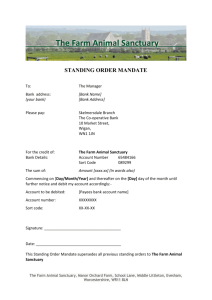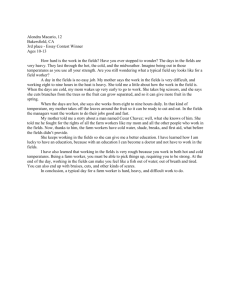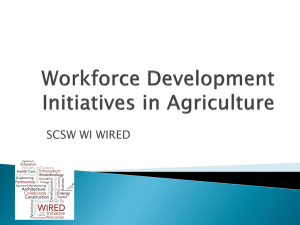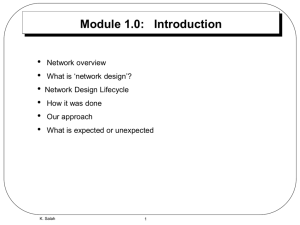Video transcript
advertisement
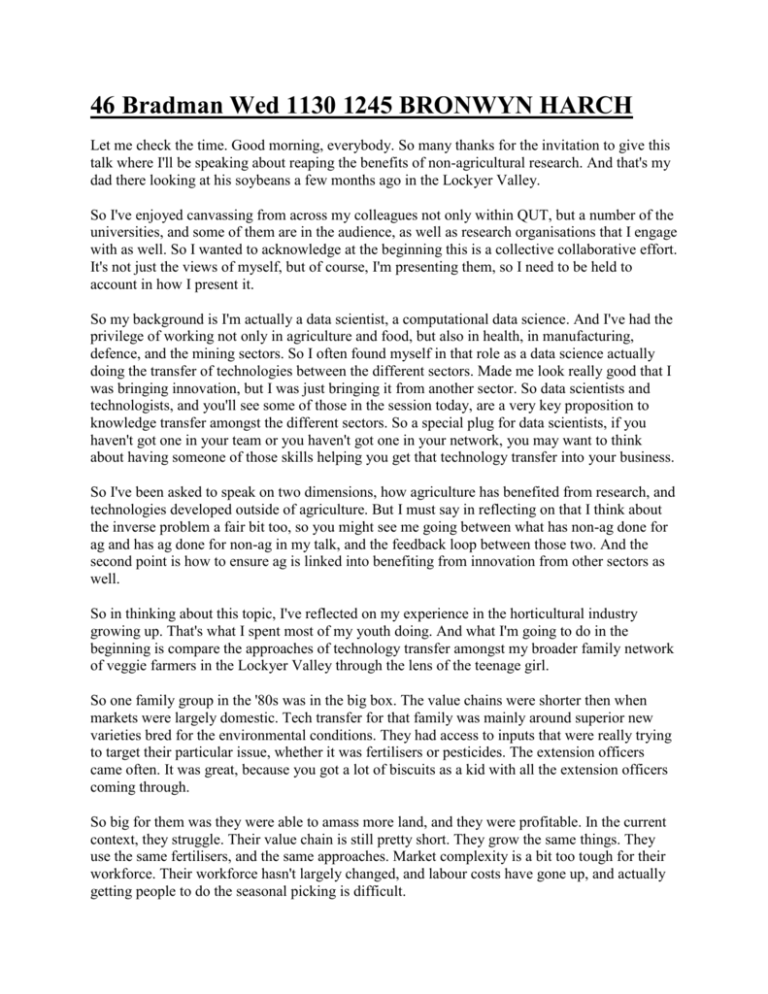
46 Bradman Wed 1130 1245 BRONWYN HARCH Let me check the time. Good morning, everybody. So many thanks for the invitation to give this talk where I'll be speaking about reaping the benefits of non-agricultural research. And that's my dad there looking at his soybeans a few months ago in the Lockyer Valley. So I've enjoyed canvassing from across my colleagues not only within QUT, but a number of the universities, and some of them are in the audience, as well as research organisations that I engage with as well. So I wanted to acknowledge at the beginning this is a collective collaborative effort. It's not just the views of myself, but of course, I'm presenting them, so I need to be held to account in how I present it. So my background is I'm actually a data scientist, a computational data science. And I've had the privilege of working not only in agriculture and food, but also in health, in manufacturing, defence, and the mining sectors. So I often found myself in that role as a data science actually doing the transfer of technologies between the different sectors. Made me look really good that I was bringing innovation, but I was just bringing it from another sector. So data scientists and technologists, and you'll see some of those in the session today, are a very key proposition to knowledge transfer amongst the different sectors. So a special plug for data scientists, if you haven't got one in your team or you haven't got one in your network, you may want to think about having someone of those skills helping you get that technology transfer into your business. So I've been asked to speak on two dimensions, how agriculture has benefited from research, and technologies developed outside of agriculture. But I must say in reflecting on that I think about the inverse problem a fair bit too, so you might see me going between what has non-ag done for ag and has ag done for non-ag in my talk, and the feedback loop between those two. And the second point is how to ensure ag is linked into benefiting from innovation from other sectors as well. So in thinking about this topic, I've reflected on my experience in the horticultural industry growing up. That's what I spent most of my youth doing. And what I'm going to do in the beginning is compare the approaches of technology transfer amongst my broader family network of veggie farmers in the Lockyer Valley through the lens of the teenage girl. So one family group in the '80s was in the big box. The value chains were shorter then when markets were largely domestic. Tech transfer for that family was mainly around superior new varieties bred for the environmental conditions. They had access to inputs that were really trying to target their particular issue, whether it was fertilisers or pesticides. The extension officers came often. It was great, because you got a lot of biscuits as a kid with all the extension officers coming through. So big for them was they were able to amass more land, and they were profitable. In the current context, they struggle. Their value chain is still pretty short. They grow the same things. They use the same fertilisers, and the same approaches. Market complexity is a bit too tough for their workforce. Their workforce hasn't largely changed, and labour costs have gone up, and actually getting people to do the seasonal picking is difficult. The other family group in the '80s, they were struggling. They couldn't get the capital that the others were getting in the valley. They were trying to be different, so they started experimenting with other crops. And they always had these different people coming and going from the farm, people that were strangers in terms of this kind of context. They had crops fail. They didn't have much income. They couldn't get their crop to the market probably because they had more perishable based things. But they kept experimenting. They went off the farm a lot speaking to the food processors, working with research organisation. They got all these grants to do wacky things on their farms. They had really weird stuff going on in my farm from my teenage girl kind of eyes. They formed partnerships with people that weren't farmers, and today they're the major exporter of vegetables, and process vegetables working with a major Australian retailer. Their workforce is fundamentally different. They've got a data scientist. They've got marketers. They've got mechatronics engineers. They've got a very varied workforce. What's been the difference? Technology transfer into their context. They've brought in financing and structuring innovation, business process management innovation, technologies on farm for automation, and through the processing that they conduct. They've even invented and created IP patents with some of the European and the north European countries. They've accessed knowledge by engaging with consumers, and collected data and analysed stuff about themselves, and try to predict the future. So that second family certainly did do tech transfer effectively to enable them to grow and compete. So that's sort of the segue into thinking about this context. Technology transfer-- why is it essential? It's the process of bringing skills, knowledge, and technologies to users so they can develop new technologies, new companies, new industries, and new jobs, and it's to benefit people, society, and the economy. It's really easy to say technology transfer. I think particularly my recent months in the university sector as well it's really easy for the assistant dean of research to be talking about we have to do technology transfer for the kinds of partnerships you need to forge. Often find you in the realm of joy, fear, frustration, and pain as well. So there's a lot that goes on in trying to do technology transfer. But it's about growth for industries, and it's about remaining competitive. In terms of a broader reflection, I thought I'd go back in time just to remind you there's nothing new in relation to technology transfer. We've always done it. Maybe it's a thing that puts the human race apart. So here with the tool of the plough and wheel, you can think about the benefits of that to the ag industry without saying. For the wheel, in terms of that inverse problem I was talking about earlier, think about the impacts the wheel has had for agriculture, but also for manufacturing, transport, logistics, and health care, to name a few. If you look at the printing press, that's how the ag community gets news about adoption, management practises, marketing. The steam engine, access to water, pumping water, moving your goods around. The light bulb. I have all these moments of remembering Dad at night time harvesting his lucerne hay. He needed the light bulb. The fluorescence that happens in greenhouses. The automobiles, moving our goods around, how that opened up markets, and access to more inputs back to the farm. Refrigeration, moving our perishable goods around to a longer distance, and then out to export markets. Communication, mobilising our labour and workforce, access to that expert advice, responding to market demand. Information and intelligence and advice that we get from landline and other ABC programmes through the communications channels. The computer, the ability to actually collect data and analyse it and even predict into the future. And lastly, the internet, where it gets all pulled together now in terms of the internet of things, where we get information, the right information at the right time. And it lets us be social in our interest groups. We get expert advice. We stay connected, particularly when the kids go off to the city for whatever period of time. So in terms of achieving technology transfer, I'm sure we're all familiar with this journey. And I said where you go through joy, pain, frustration, or relief whether you're a technologist or someone keen to get the benefits. For technology transfer, we often think about this distribution of benefits, reconsidering leaders, the majority, the laggards. And it's along this continuum of productivity, and the number of farmers that I wanted to reflect on. So the leaders and early adopters in terms of technology, they're open to things like that one family I spoke about. They have the high capability and work force, and striving to be the best. And the majority and mainstream are more conservative, don't have as much capability as yet, or the technology to be able to adopt it is more complex. And so what we're trying to do with technology transfer is can we change the graph to being the red distribution where you shift the whole curve to the right, and importantly, how can we compress that? And we're seeing a lot of these examples at the moment, and my other speakers will be showcasing that in terms of how to shift these curves across. So in terms of the impacts from technology transfer, what is the sector looking for at the moment? And there's been a fair amount of dialogue across research and industry. These are some thoughts that I've put together around. They're looking for impacts around efficient farm management, resource efficiency, traceability, and supply chain efficiency. So with these as a lens to look through, I wanted to reflect on some key technologies that are occurring in the landscape at the moment. So I start with the one that's closest to my heart, which is around agri-intelligence. We're having Tim speak about precision agriculture, so precision agriculture is going through this change to being agri-intelligence. So here, it's about real-time diagnosis and traceability is one of the key things driving this. Where we're having sensors that integrate, and give you risk informed decision making for prediction within season. And up there. I've got the kinds of sensors that people are looking for. For precise feeding, fertiliser and water management, easier detection of disease, intelligent cooling, and transport and storage as well. One of the challenging around agri-intelligence is having the ability to have all that data linked from whether you are doing it on a tractor, from a satellite, whether it's your own mobile phone that you're using as a sensor is how do you have markup languages that bring all this information together. For services industries who actually be created where they're actually a knowledge and information broker for the ag and food sector. The next one relates to, actually the other thing I wanted to mention on agri-intelligence with human wearables is that serious games are being introduced into this sector to help with training as well. In biosecurity, there's some projects we're doing where they can't train enough people at the right standards, so they're actually using wearable technologies with human computer interaction for people be trained through a serious game for biosecurity related training for companies. With automation-- and Salah will speak a lot to this topic-- one of the main things this can be used for is checking and maintaining crops and livestock particularly at the individual level. This is where things are being moved to. As humans, we want to be looked after in terms of our individual needs. And increasingly, a lot of the automation and autonomous systems that are being developed will be able to look at things on a individual basis. So it's taking that precision right through to the extreme. In engineering, there's this extending the reach of agriculture, and you'll see some major corporates moving into this as a separate value proposition from their farm where it's about the circular economy on farm or in a region, thinking about biorefining and waste to energy. Also considering aspects of farming in urban settings. And lastly, smart devices and serious games again in the context of reaching out from agriculture into the circular economy. The last one is around advanced materials where here the technologies are helping with reducing costs and efficiencies, looking at inputs in their delivery. So there's work going on where you can deliver fertiliser or nutrient in bursts, and so how can you get that in the soil that it's not all released at once, but it's burst in through the soil getting those nutrients further down. 3D printing. We've seen in the news recently where CSIRO's been doing this for engines, and so there's certainly a lot of spill outs out of the 3D printing that will be very important for agriculture. So there may be another business in the ag services area or particular corporate stew around 3D printing for parts. Light weight materials are really important as well. I'm sure Salah [? Salah ?] will reflect on the different kinds of robotics whether it's an AgBot or a UAV or the Farm Swarm. A lot of these issues relate to the weight of a lot of the robots, and having to stop compaction. So light weight materials with titaniums and other things are really important for thinking about in the ag context. As well as energy storing and the delivery of energy storage, because of the huge input costs that agriculture has as it related to energy. In conclusion, I just wanted to reflect on how we can ensure these forms of tech transfer actually continue. I'm confident that they will continue, but how can we get them to accelerate? So apart from having data scientists on your team, how do you interact with technologies to get them into your workflows? And there's a book I've read recently called The Necessity of Strangers, so I wanted to leave you with that that when you're getting together have you got the same people sitting around the table? Are you bringing in people from different industries to actually help you with your own industries? So with that, I'll just underline the necessity of strangers for innovation. Thank you.




